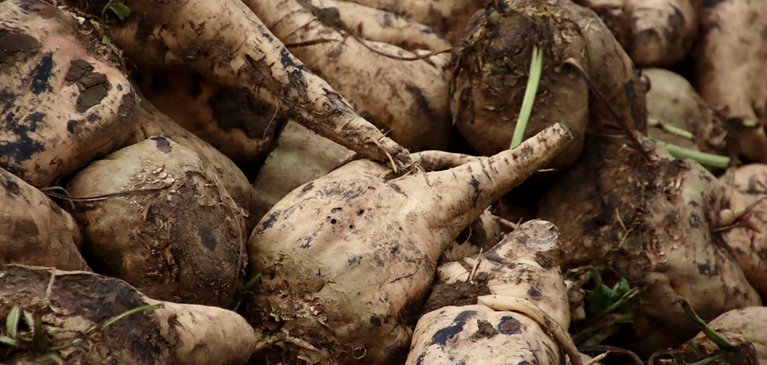
Despite a cold, wet spring that delayed some planting and then a dry June, Michigan’s sugarbeet crop is shaping up nicely and with favorable demand fueling strong sugar prices that could lead to a profitable 2023 crop.
Michigan Sugar Company, the farmer-owned cooperative that processes all the beets in Michigan, says even some of the later planted beets are making strides on those that got in earlier.
Growers are also excited about the market outlook, as the world’s sugar supply is in tight demand and sugar prices are near ten-year highs, according to Kim Knoerr, vice president of agribusiness lending for GreenStone Farm Credit Service who farms with his brother in Freeland, Michigan and raises sugar beets.
Knoerr added “I recently learned from a Michigan Sugar meeting, demand has pulled back slightly recently, as our customers work through inventory they built up through the COVID-19 supply chain issues. But overall, the 2023 crop for Michigan sugar is priced at high levels compared to the ten-year average,” he says. “And about 90% of the 2023 crop that’s growing right now is already contracted.”
Some of the high demand is fueled by lower production in sugar producing areas like Thailand and India, who are experiencing El Nino.
Mexico, which used to dump a lot of sugar into the U.S. market until the antidumping trade agreement, is struggling to meet domestic demand. Mexico's sugarcane crop is on the latter years of its ten-year life span.
“The first half produces the most sugarcane, the second half doesn't produce as much,” Knoerr explains. “There's a lot of small-scale farmers in Mexico, and with high inputs, they just don't have the money to replant their sugarcane crop.”
"About 50% of the Mexican crop is in the second half of maturity, causing production to fall", he adds.
Projected harvest
Michigan growers planted 140,708 acres of sugarbeets and the projected harvest is 30.5 tons. Early dig harvest is set for the first full week of September and the campaign, according to Michigan Sugar, will run from Sept. 8 to a projected end date of March 27 or 28.
Michigan Sugar Company, with new CEO Neil Juhnke, is zoning in on factory performance. Juhnke, an engineer by trade and North Dakota native, was Ag operations manager for American Crystal sugar company and was an integral part in the implementation of a molasses desugarization plant 20 years ago in the Red River Valley.
“He’s looking to implement new procedures to help the factory run more efficiently, we are fortunate to have Neil here with his vast knowledge of the beet industry” Knoerr says. “There's a lot of optimism about increasing efficiently.”
Crop conditions
Planting conditions this spring were not ideal and Knoerr, like many growers, didn’t get his crop in the first week of April, like he prefers. Instead, he started planting April 15. “Our beet stand counts are down some, but because we are in 20-inch rows, (about half the growers plant in 30-inch rows), I still think we can obtain a good yield with the stand counts we have.”
In the Freeland area, where Knoerr is farming, recent rains have more than satisfied crop needs. “We’ve gotten too much rain in the last couple weeks, producing some crop damage,” he says. “But overall, our crop looks good. I expect an average crop; it could potentially be slightly above average. It just depends on what Mother Nature does.”
Overall, Michigan Sugar’s agronomy team reports 40% of the crop is in excellent condition, 40% is in good condition, 15% is in fair condition, and 5% is in poor condition. The first full sample, taken on Wednesday, July 26, showed an average yield of 13.5 tons per acre, ahead of the five-year average at this time of 13.2 tons per acre.
Knoerr averaged 31 tons per acre last year and is expecting between 31-32 tons this year with the early dig. “For the early dig, which pays a premium and spaces out harvest, we’ll probably have 20-25 tons per acre in September, but our October harvest will likely produce more like 32-35 tons per acre,” he explains.
But all that could change, as they did in 2021 when Michigan growers produced the largest crop on record. Fall rains remained persistent and the warm and sunny growing conditions prompted so much growth, growers were told to leave a portion of their crop in the ground. “That’s a worry going forward,” Knoerr says. “We don’t want a repeat of a lot of tonnage and short on sugar. We have a green light right now, but weather mainly controls sugar content to finish the crop and pounds of sugar per acre is what growers get paid on. At this point, there’s really nothing we can do besides be very diligent in spraying for Cercospora leaf spot.”
Desugarization facility update
Work is progressing to build a new molasses desugarization facility in Bay City, Michigan. Project costs were originally estimated at $66 million, however estimates in the spring of 2022 put the cost at $75-plus million.
Once operational, projected to come online by July 2024, the new facility is expected to add, on average over a 10-year period, roughly $18 million annually to the beet payment.
"Desugaring" all the molasses will allow Michigan Sugar to produce up to an additional 80 million pounds of pure, all- natural sugar annually without planting another acre of sugarbeets. Currently, Michigan Sugar has the capacity to extract additional sugar from 60% of its molasses. Once completed, the company expects to process as much as 650 tons of molasses daily, up from the current amount of 325 tons per day.


